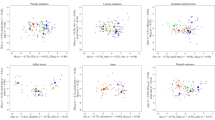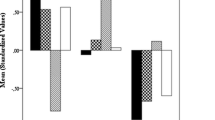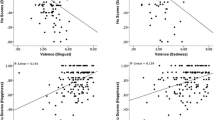Abstract
Electronically synthesized tone sequences with systematic manipulation of amplitude and pitch variation, pitch level and contour, tempo, envelope, and filtration were rated on emotional expressiveness. The results show that two-thirds to three-quarters of the variance in the emotion attributions can be explained by the manipulation of the acoustic cues, and that a linear model of the judges' cue utilization seems to be a good approximation to their response system. Implications for phylogenetic and ontogenetic aspects of the vocal expression of emotion and for the psychology of music are discussed.
Similar content being viewed by others
References
Brunswik, E.Perception and the representative design of psychological experiments. Berkeley and Los Angeles: University of California Press, 1956.
Brunswik, E., & Reiter, L. Eindrucks-Charaktere schematisierter Gesichter.Zeitschrift für Psychologie 1937,142 67–134.
Cohen, J. Multiple regression as a general data-analytic system.Psychological Bulletin 1968,70 426–443.
Cohen, J., & Cohen, P.Applied multiple regression/correlation analysis for the behavioral sciences. Hillsdale, N.J.: Lawrence Erlbaum, 1975.
Davitz, J. R.The communication of emotional meaning. New York: McGraw-Hill, 1964.
Ekman, P. Universal and cultural differences in facial expression of emotion. In J. Cole (Ed.),Nebraska Symposium on Motivation, 1972. Lincoln: University of Nebraska Press, 1972.
Farnsworth, P.The social psychology of music. New York: Dryden, 1958.
Gundlach, R. A quantitative analysis of Indian music.American Journal of Psychology 1932,44 133–145.
Hevner, K. Experimental studies of the elements of expression in music.American Journal of Psychology 1936,48 246–268.
Kramer, E. The judgment of personal characteristics and emotions from nonverbal properties of speech.Psychological Bulletin 1963,60 408–420.
Lundin, R.An objective psychology of music. New York: Ronald, 1953.
Marler, P. Social organization, communication and graded signals: The chimpanzee and the gorilla. In P. P. G. Bateson & R. A. Hinde (Eds.),Growing points in ethology, Cambridge: Cambridge University Press, 1976.
Meyer, L.Emotion and meaning in music. Chicago: University of Chicago Press, 1956.
Plutchik, R.The emotions: Facts, theories, and a new model. New York: Random House, 1962.
Rappoport, L., & Summers, D. A. (Eds.),Human judgment and social interaction. New York: Holt, Rinehart & Winston, 1973.
Rohracher, H.Charakterkunde. Wien: Urban and Schwarzenberg, 1975.
Rosenthal, R. Estimating effective reliabilities in studies that employ judges' ratings.Journal of Clinical Psychology 1973,29 342–345.
Scherer, K. R.Nonverbale Kommunikation. Hamburg: Buske (IPK-Forschungsbericht), 1970.
Scherer, K. R. Judging personality from voice: A cross-cultural approach to an old issue in interpersonal perception.Journal of Personality 1972,40 191–210.
Scherer, K. R. Acoustic concomitants of emotional dimensions: Judging affect from synthesized tone sequences. In S. Weitz (Ed.),Nonverbal communication. New York: Oxford University Press, 1974.
Scherer, K. R.Personality inference from voice quality: The loud voice of extraversion. Unpublished manuscript, 1976.
Scherer, K. R. Non-linguistic vocal indicators of emotion and psychopathology. In C. E. Izard (Ed.),Emotions and psychopathology. New York: Plenum Press, in press.
Scherer, K. R., Koivumaki, J., & Rosenthal, R. Minimal cues in the vocal communication of affect: Judging emotions from content-masked speech.Journal of Psycholinguistic Research 1972,1 269–285.
Slovic, P., & Lichtenstein, S. Comparison of Baysian and regression approaches to the study of information processing in judgment. In L. Rappoport & D. A. Summers (Eds.),Human judgment and social interaction. New York: Holt, Rinehart & Winston, 1973.
Strongman, K. T.The psychology of emotion. London: Wiley, 1973.
Tembrock, G.Biokommunikation. Informationsübertragung im biologischen Bereich. Berlin: Akademie-Verlag, 1971.
Vitz, P. C. Affect as a function of stimulus variation.Journal of Experimental Psychology 1966,71 74–79.
Zajonc, R. B. Attitudinal effects of mere exposure.Journal of Personality and Social Psychology 1968,9 1–29.
Author information
Authors and Affiliations
Additional information
This paper is based on research supported by NIMH grant MH 19-569-01 to the first author while at the University of Pennsylvania. The authors gratefully acknowledge comments and suggestions by Paul Ekman, Ursula Scherer, and two anonymous reviewers.
Rights and permissions
About this article
Cite this article
Scherer, K.R., Oshinsky, J.S. Cue utilization in emotion attribution from auditory stimuli. Motiv Emot 1, 331–346 (1977). https://doi.org/10.1007/BF00992539
Issue Date:
DOI: https://doi.org/10.1007/BF00992539




